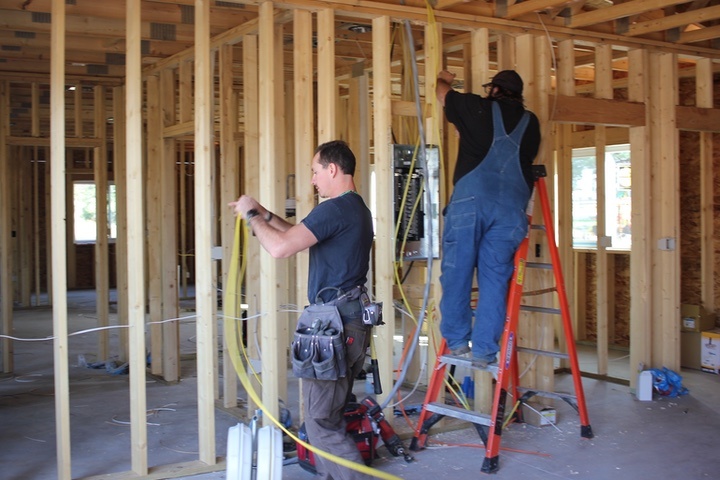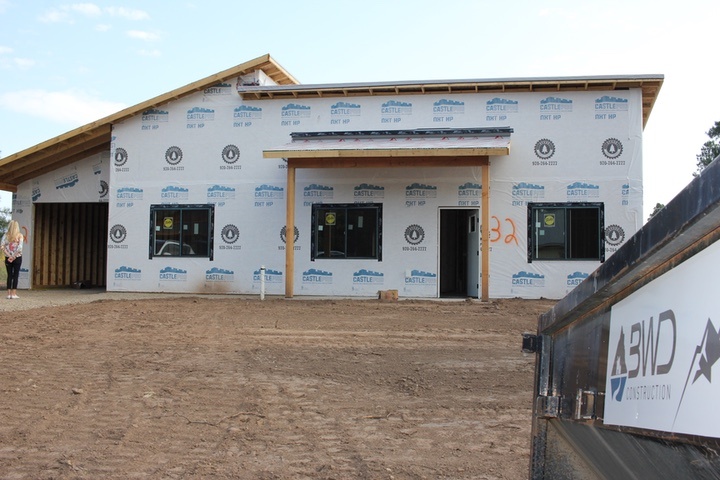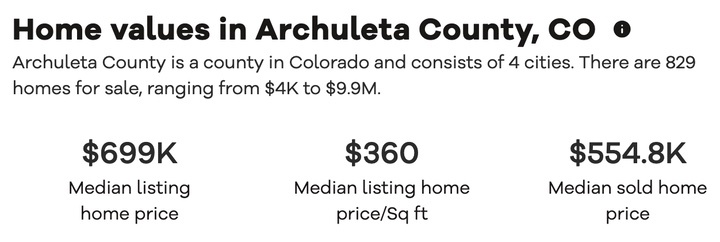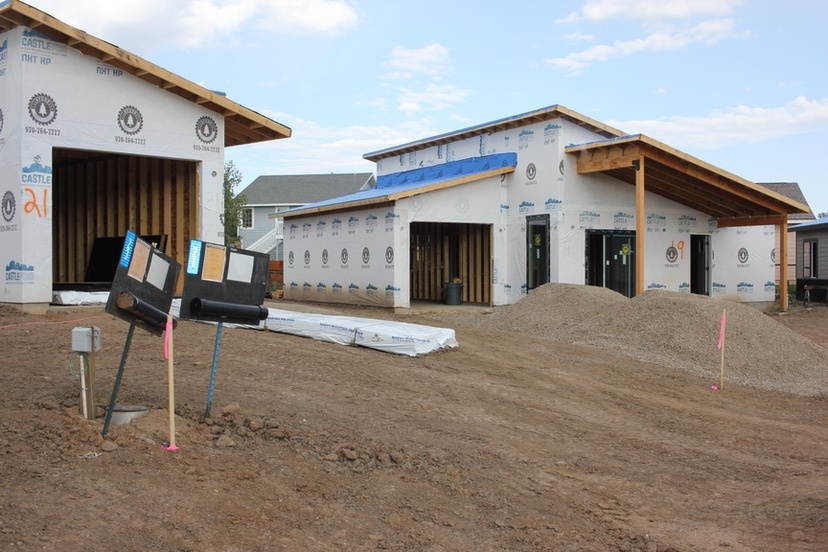Photo: A PSCDC tour of ten new workforce housing units going up in Trails subdivision, September 5, 2024.
As mentioned yesterday, I had the pleasure, earlier this month, to tour a housing project in the Trails and Chris Mountain subdivisions. Leading the tour was Emily Lashbrooke, Executive Director of the Pagosa Springs Community Development Corporation, along with PSCDC Administrative Manager, Kathleen McFadden. Along for the tour was Archuleta County Commissioner Veronica Medina, Town of Pagosa Springs Community Development Director James Dickhoff, and newly-hired Jeff Sams, PSCDC’s Multi-Jurisdiction Housing Coordinator.
The homes are being built by BWD, a local construction company, with financing arranged by PSCDC.
Are these homes “weird”? We might very well make that claim, if by “weird” we mean “out of the ordinary”.
The ten “workforce” homes currently under construction are the result of considerable community cooperation. The vacant parcels, abandoned to the County government primarily through a failure to pay property taxes, were donated to PSCDC by our County commissioners, who also granted a five-year waiver of future County property taxes if the homes are sold to working families with below-median incomes.
Pagosa Area Water and Sanitation similarly granted waivers of certain water and sewer fees, for below-Area-Median-Income buyers.
State grants will cover about $55,000 of the sales price for each home, which will end up in the $320,000 to $390,000 range for the eventual buyers.
It’s possible that LPEA will agree to a waiver as well, for hooking up the electricity. TBA.

Because the parcels are located within the Pagosa Lakes Property Owners Association (PLPOA) boundaries, the homes had to meet PLPOA requirements — a certain minimum square footage, for example, and a requirement to have a garage — as well as Archuleta County building code requirements. But PLPOA did waive certain fees.
In Part Two of this editorial series, I quoted from the 2007 Regional Parks, Recreation, Open Space & Trails Master Plan, which you can download here.
While the population has steadily increased, a low unemployment rate has been maintained in place. Low unemployment rates in Archuleta County are highly dependent on “generally low paying retail and service sector jobs, driven primarily by the tourist and resort industry.” In 2003, The Operation Healthy Communities (OHC) calculated that a wage of $10.36/hour was the baseline livable wage for a single individual renting a one bedroom apartment. Additionally, only about 42% of the population in Archuleta County could afford a median priced home of $181,000.
Vision Statement
“Archuleta County will retain, grow and support our local businesses, and encourage a diverse economic base through business attraction and creation to ensure year-round livable wages for the residents of our County.”
Rather than retaining, growing and recruiting businesses to create a diverse economic base, however, the Town Council and the Archuleta BOCC cooperated, in 2010, to create the Pagosa Springs Community Development Corporation to expand the “generally low paying jobs ” in the tourist and resort industry.
Then the two governments further augmented their efforts to increase recreation and tourism (and thus, low-paying tourist and resort industry jobs) by forming the Pagosa Springs Area Tourism Board, which has recently been spending around $1.5 million per year supporting tourist and resort businesses.
In a weird turn of events, the PSCDC has dramatically changed its mission over the past couple of years, away from supporting tourism and towards workforce housing, as evidenced by the PSCDC’s plan to build perhaps 40-50 workforce-oriented homes over the next few years. This difficult work will be further supported by Prop 123 funding from the state government, as approved by Colorado voters in 2022.
The ten PSCDC homes currently under construction this year have similar “Mountain Resort Modern” styling — or perhaps you could call it “Mountain Resort Semi-Affordable Styling” — but come in different sizes, with different numbers of bedrooms, to meet different income levels. But the lowest priced homes — priced at $320,000 — are not exactly what I would classify as “affordable”.

From NerdWallet.com:
To calculate ‘how much house can I afford,’ a good rule of thumb is using the 28/36 rule, which states that you shouldn’t spend more than 28% of your gross, or pre-tax, monthly income on home-related costs and no more than 36% on total debts, including your mortgage, credit cards and other loans, like auto and student loans.
Example: If you earn $5,500 a month and have $500 in existing debt payments, your monthly mortgage payment for your house shouldn’t exceed $1,480…
A household income of $5,500 a month equals about $66,000 annually. If this family has ‘average’ debt payments, they can comfortably afford a home costing about $220,000 (according to BankRate.com).
That’s assuming they have $40,000 to use as a down payment. (USDA Rural Development has loans for first-time home buyers that don’t require a down payment. If you qualify.)
But still… $220,000 is a lot less than $320,000. How many working families bring in the $86,000 a year suggested by BankRate.com for a smallish “Mountain Resort Modern” home in the Trails subdivision?
Good question.
Back in 2021, local nonprofit Pagosa Housing Partners surveyed 464 working families and found that most of them earned less than $86,000 per year. Most of them earned a lot less.
In fact, according to that survey, 80% of working families in Archuleta County cannot afford a $320,000 house. And that’s apparently the lowest price home that PSCDC and BWD have for sale this year.

My hat is off to PSCDC and BWD for making a real effort to address our housing crisis. Hopefully, ten households will be moving into a new home in early 2025, and even more families will have homes in 2026 and 2027.
But the size of the crisis boggles the mind. If the 464 households that responded to the 2021 Pagosa Housing Partners survey are representative of our overall workforce, we have 5,900 workers who cannot afford a home costing $220,000… to say nothing of $320,000. Fortunately, many of those 5,900 employees bought a home, or found a rental situation, before the crisis got this bad.
The median listing price for a home in Archuleta County is, according to Realtor.com, $699,000. (I’m not aware of the “4 cities” in our county, however.)

Employees in rental situations are not necessarily in a good place. Rents here have typically tripled since 2010.
So, a key question is: What are our community leaders doing about this? Leaders in government, business, the nonprofit sector, churches, associations, clubs…?
Because it would be really weird, if we could actually solve this problem.

